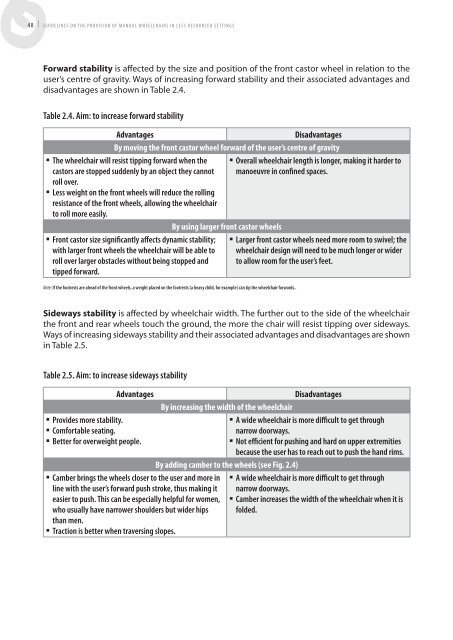Manual Wheelchairs - World Health Organization
Manual Wheelchairs - World Health Organization
Manual Wheelchairs - World Health Organization
You also want an ePaper? Increase the reach of your titles
YUMPU automatically turns print PDFs into web optimized ePapers that Google loves.
48 I guIdelInes on the provIsIon of manual wheelchaIrs In less resourced settIngs<br />
Forward stability is affected by the size and position of the front castor wheel in relation to the<br />
user’s centre of gravity. Ways of increasing forward stability and their associated advantages and<br />
disadvantages are shown in Table 2.4.<br />
Table 2.4. Aim: to increase forward stability<br />
Advantages Disadvantages<br />
By moving the front castor wheel forward of the user’s centre of gravity<br />
n The wheelchair will resist tipping forward when the<br />
castors are stopped suddenly by an object they cannot<br />
roll over.<br />
n less weight on the front wheels will reduce the rolling<br />
resistance of the front wheels, allowing the wheelchair<br />
to roll more easily.<br />
n Front castor size significantly affects dynamic stability;<br />
with larger front wheels the wheelchair will be able to<br />
roll over larger obstacles without being stopped and<br />
tipped forward.<br />
By using larger front castor wheels<br />
Note: If the footrests are ahead of the front wheels, a weight placed on the footrests (a heavy child, for example) can tip the wheelchair forwards..<br />
n Overall wheelchair length is longer, making it harder to<br />
manoeuvre in confined spaces.<br />
n larger front castor wheels need more room to swivel; the<br />
wheelchair design will need to be much longer or wider<br />
to allow room for the user’s feet.<br />
Sideways stability is affected by wheelchair width. The further out to the side of the wheelchair<br />
the front and rear wheels touch the ground, the more the chair will resist tipping over sideways.<br />
Ways of increasing sideways stability and their associated advantages and disadvantages are shown<br />
in Table 2.5.<br />
Table 2.5. Aim: to increase sideways stability<br />
n Provides more stability.<br />
n Comfortable seating.<br />
n Better for overweight people.<br />
Advantages Disadvantages<br />
By increasing the width of the wheelchair<br />
n Camber brings the wheels closer to the user and more in<br />
line with the user’s forward push stroke, thus making it<br />
easier to push. This can be especially helpful for women,<br />
who usually have narrower shoulders but wider hips<br />
than men.<br />
n Traction is better when traversing slopes.<br />
By adding camber to the wheels (see Fig. 2.4)<br />
n A wide wheelchair is more difficult to get through<br />
narrow doorways.<br />
n not efficient for pushing and hard on upper extremities<br />
because the user has to reach out to push the hand rims.<br />
n A wide wheelchair is more difficult to get through<br />
narrow doorways.<br />
n Camber increases the width of the wheelchair when it is<br />
folded.

















